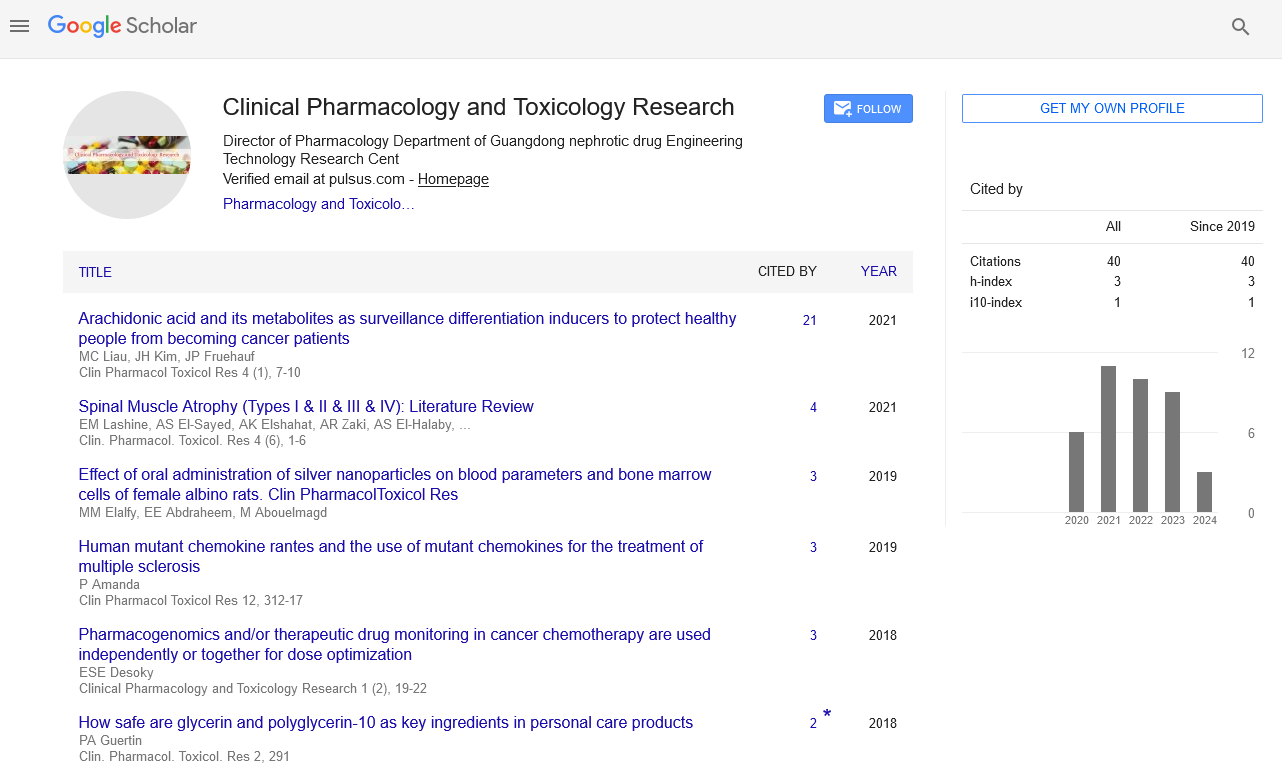Clinical Pharmacology and Toxicology Research–Insight
Received: 10-Jul-2000 Accepted Date: Jul 17, 2000; Published: 24-Jul-2000
Citation: Lorenzo G. Clinical Pharmacology and Toxicology Research–Insight. Clin Pharmacol Toxicol Res. 2020;3(2):2.
This open-access article is distributed under the terms of the Creative Commons Attribution Non-Commercial License (CC BY-NC) (http://creativecommons.org/licenses/by-nc/4.0/), which permits reuse, distribution and reproduction of the article, provided that the original work is properly cited and the reuse is restricted to noncommercial purposes. For commercial reuse, contact reprints@pulsus.com
About The Journal
On behalf of the Board of Clinical pharmacology And Toxicology Research (CPTR), I am gratified to present the Volume 3 Issue 2 of the journal. Our Journal was organized in the year 2017, releasing 2 issues every year and was running successfully since then. This is a peer reviewed and an open access journal which reflects all types of articles. Our articles include original articles, full-length research articles, critical reviews, case reports, mini reviews and short communications [1].
The journal has been achieved a lot in these 4 years by the constant encouragement and support given by the board members. CPTR journal is running successfully with the utmost coordination of board members, readers, researchers and reviewers. Our journal is indexed in Google scholar, Index Copernicus, CNKI and other databases. This journal follows double blind peer review process in which the details of authors were not revealed to each other. The journal homepage itself gives the authors a complete knowledge of the journal [2]. Authors can easily submit their manuscripts through the homepage itself. They can check every aspect of our journal in the homepage. Users can check the aims and scope, editorial board, details for authors, articles & issues and details of subscription, advertise, reprints and permissions.
Journal Topics
Clinical Pharmacology and Toxicology Research reveals the information about the consequences of toxicology and pharmacology. It gives a brief knowledge of topics like different types of toxicology, methods of toxicology and pharmacology, importance of toxicology in all the fields, pharmacology of various drugs, clinical trials of drugs, pharmacodynamics, pharmacokinetics, use of pharmacology in different streams like cardiology, genetics, biochemistry, therapeutic drug management, workplace drug testing and many others.
Clinical Pharmacology and Toxicology are the main objectives of this journal. Clinical Pharmacology explains about the drugs used in different fields of medicine. It is used to analyze the adverse effects of drugs, their therapeutic uses, toxic effects and the management of drugs [3].
Insight of the Journal
Clinical Pharmacology explains that the drugs used by a person must be prescribed by a doctor or a medical practitioner. Otherwise it may lead to toxic results. To consume a drug, one must know the pharmacology of the drug. So, clinical pharmacology plays a vital role in medicine. Toxicology also has utmost importance in drug intake. The drug dosage, type of drug present and type of food taken with also play an important role in drug toxicity [4]. Not all drugs give same reaction in every person. The effect of the drug varies from person to person based on their immunity and the reaction of antibodies.
Toxicologists compare and test the toxicity of drugs. They test the drug interactions with other drugs and foods. Drug interactions are the main source of toxicity. Many clinical trials have been done every time before releasing the drug into the market. People who prefer Over the Counter (OTC) type of drugs frequently were mostly affected by the drug interactions. Toxicity is tested by experimenting in vivo or in vitro or in silico methods. The level of toxicity is referred to as LD50 [5]. Toxicity is applicable to human beings and as well as animals and birds. When toxicity increases in the body person cannot withstand it anymore and the organs start failing gradually.
Social Media
Use of multiple social media platforms like Twitter, LinkedIn and Facebook may be useful for all the research scholars to improve the knowledge of different journals.
Twitter: through twitter one can easily post and interact with each other by messages which are known as “tweets”.
LinkedIn: it is a professional networking site through which users can contact each other by sharing their profiles.
Facebook: here users can interact with each other through messages and multimedia.
REFERENCES
- LoetscherP, Seitz M, Clark-Lewis I,et al. Activation of NKcells by CC chemokines. Chemotaxis, Ca2+ mobilization, and enzyme release. Clin Pharmacol Toxicol Res. 2017;156:322-27
- Amanda P. Human mutant chemokine rantes and the use of mutant chemokines for the treatment of multiple sclerosis. Clin Pharmacol Toxicol Res. 2019;12:312-17.
- Moskalev AV. The role of chemokines in the development of an antiviral immune response Clin Derma Toxicol Res. 2017;3:183-88.
- Stellato C, BeckLA. Chemokines: Keyplayers in innate and adaptive immunity. Clin Pharmacol Toxicol Res. 2018;125:615-28.
- Mackay CR, Lanzavecchia A. The role of chemokine receptors in primary, effector, and memory immune responses. Annu Rev Immunol. 2000;18:593-620.





